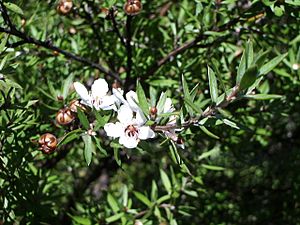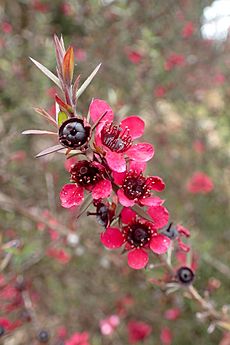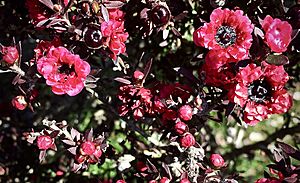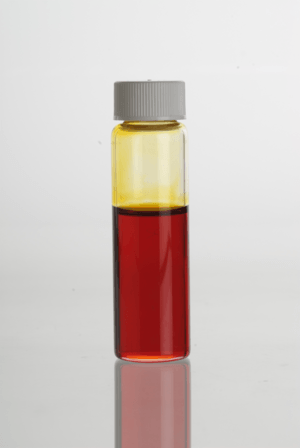New Zealand teatree facts for kids
Quick facts for kids New Zealand teatree |
|
|---|---|
 |
|
| Leptospermum scoparium foliage and flowers | |
| Scientific classification | |
| Genus: |
Leptospermum
|
| Species: |
scoparium
|

Leptospermum scoparium, often called mānuka or tea tree, is a type of flowering plant. It belongs to the myrtle family, Myrtaceae. This plant is originally from south-east Australia and New Zealand, including the Chatham Islands.
Contents
About the Mānuka Plant
Mānuka is a plant that grows quickly and often appears first in areas where land has been cleared. It usually grows as a shrub between 2 to 5 meters (about 6.5 to 16 feet) tall. But it can also become a medium-sized tree, reaching up to 15 meters (about 49 feet) high.
This plant is evergreen, meaning it keeps its leaves all year round. It has many branches and small leaves. These leaves are about 7 to 20 millimeters long and 2 to 6 millimeters wide. Each leaf has a short, spiky tip.
The flowers of the mānuka plant are usually white, but sometimes they can be pink. They are about 8 to 15 millimeters across, but can sometimes be as large as 25 millimeters. Each flower has five petals. The wood of the mānuka is very strong and hard.
Mānuka vs. Kānuka
People often mix up mānuka with a similar plant called kānuka (Kunzea ericoides). Here's an easy way to tell them apart:
- Mānuka leaves feel prickly when you touch them.
- Kānuka leaves feel soft.
Another difference is their seed pods. Mānuka has larger seed pods, about 5 to 7 millimeters wide. These pods often stay on the plant all year. Kānuka's seed pods are much smaller, about 2.2 to 4.6 millimeters wide, and they are not on the plant for most of the year.
The scientific name scoparium means "like a broom." This is because the plant looks a bit like broom plants found in other parts of the world.
Where Mānuka Comes From
Scientists believe that Leptospermum scoparium first grew in Australia. This was before Australia became very dry a long time ago. The plant then spread to New Zealand from eastern Australia over the last 20 million years. This likely happened because strong winds, like cyclones, carried its seeds across the ocean.
Mānuka plants have special features that help them survive wildfires. For example, their seeds can stay closed until a fire opens them, and they have special growths that help them regrow after a fire. These features are common in plants from Australia, where fires are frequent.
When mānuka arrived in New Zealand, it first grew in only a few places with the right soil. But when the first people, the Polynesians, came to New Zealand, they cleared forests and used fire. This created more areas with low-nutrient soil, which mānuka was already good at growing in. Now, mānuka is more common in New Zealand than in Australia. You can find it all over New Zealand, especially on the drier east coasts. In Australia, it grows in Tasmania, Victoria, and New South Wales.
Mānuka's Environment
Pests and Diseases
In New Zealand, the adult mānuka beetle and its young (larvae) eat the L. scoparium plant.
Pollinators
Many different insects help pollinate mānuka flowers. Some examples include hoverflies (like Melangyna novaezelandiae), native bees (like Hylaeus), and honeybees.
How Mānuka Changes Over Time
Leptospermum scoparium is slowly changing as it grows separately from other plants in the Leptospermum family. For example, mānuka plants in parts of New Zealand's South Island, where there are fewer fires, have lost some of their fire-survival features. But plants in Australia and Tasmania still have these features strongly.
Also, mānuka plants from Australia have different chemicals in them compared to those from New Zealand. Even within New Zealand, there are different types of mānuka with different chemical makeups.
Names for Mānuka
Some common names for this plant are "tea tree," "mānuka," and "kāhikatoa." The name "tea tree" came about because Captain Cook used the leaves to make a 'tea' drink.
"Mānuka" is a word from the Māori language in New Zealand.
Growing Mānuka in Gardens
Many different types of mānuka, called cultivars, have been created for gardens. Some of these have won awards for being great garden plants, such as:
- 'Kiwi' (from the Nanum Group)
- 'Nichollsii Nanum'
- 'Red Damask'
- 'Silver Sheen'
Even though many cultivars are available in New Zealand, the plant often grows better in gardens in other countries. This is because in its home country, mānuka can be attacked by tiny insects called scale insects. These insects produce a sticky substance called honeydew, which then grows a black mold. This mold can make the plant weak. Because of this problem, people have tried to mix New Zealand mānuka plants with mold-resistant Australian Leptospermum species, but it has been hard to do this successfully for commercial use.
Uses of Mānuka
The strong wood of the mānuka tree was often used to make tool handles. Mānuka sawdust gives a delicious flavor when used for smoking meats and fish.
In New Zealand, mānuka is grown for its special mānuka honey. This honey is made when honeybees collect nectar from mānuka flowers. The plant is also used by the pharmaceutical industry to make medicines. Mānuka wood is also popular for carving.
An essential oil is made by steaming the leaves of the mānuka plant. Many people believe this oil has medicinal benefits. The Māori people used mānuka in many ways before Europeans arrived, and they still do today.
- They drank a special liquid made from the leaves to help with urinary problems and to reduce fevers.
- They breathed in the steam from leaves boiled in water to help with head colds.
- They rubbed a warm liquid made from the leaves and bark on stiff muscles and aching joints.
- A soft, white gum from the plant, called pai Manuka, was given to babies and used to treat burns.
- Chewing the bark is said to help people relax and sleep better.
Parakeets and Parasites
Kākāriki parakeets (a type of bird) use the leaves and bark of both mānuka and kānuka to get rid of parasites. They not only eat the plant material, but they also chew it up, mix it with oil from their preen gland, and spread it on their feathers.



